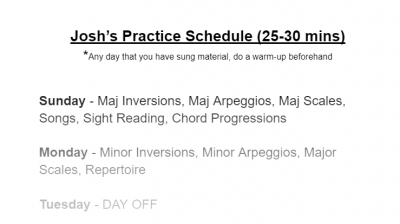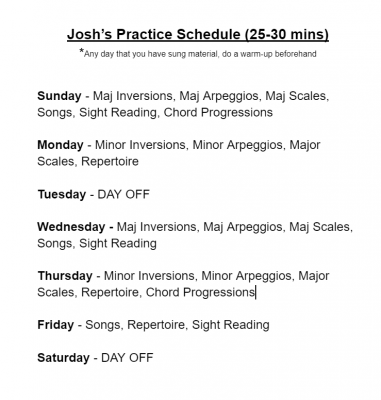Creating a Practice Schedule

Having a properly curated practice schedule is a crucial tool for any student that wants to make serious progress. You’ll be able to not only break up your practice into manageable sections and durations, but also make sure that you’re hitting all of the areas of practice that are expected from your teacher.
Generally, the students that want to follow a practice schedule the least are the ones that need to use their schedule the most. That being said, not every student is great at time management, so some students may just forget to check their schedule. That’s why, first and foremost, it’s recommended to have an alarm scheduled on all practice days to remind the student to not only practice, but to make sure they are doing so based on what is outlined in their schedule.
Next, let’s cover some basic tips to make sure you get the most out of your practice schedule. Remember to create this schedule with your teacher so that you can outline what other extra curricular activities need to be consider.
1) How many days can you practice?
As a general rule, a student taking lessons should practice no less than 3 days per week. Although, it’s recommended to practice 4-6 times per week so that you can more easily break up your practice over more days, and make for a more managable practice session each day.
2) How long should you practice for?
This is generally agreed upon by both the teacher and student, but even for beginner students 20 minutes is a good minimum amount of time to be at your instrument. From there, some students may need to get up to 2 hour + depending on the level they are studying and their goals in terms of testing. However, as a general rule, 30-60 minutes on each practice day is appropriate for intermediate students that either wish to study conservatory grades, or are preparing for a recital or post-secondary application.
3) How to divide your practice.
This one is perhaps the most dynamic category within this blog, as it’ll vary greatly between each student. Often, grouping major technical categories on some days, and minor categories on other days can be helpful, as think ing of your practice day at a glance becomes quite managable. It’s also recommended to do some song and sight reading material every day that you practice. Other categories such as theory/harmony, history, composition, should be approach at a different time. This allows the student to focus on their playing and technical practice in one session, and the more theory/history based material at a separate time. So, for an intermediate student studying for a RCM grade, their practice may be divided as follows.
- sight read 5-10 minutes to warm-up brain - technical 15-20 minutes to warm-up hands - newer song material 20-25 minutes - older song material 10-15 minutes *TAKE A BREAK* - theory OR history OR composition, etc. (30+ minutes)
You can see, the time at your instrument can add up quickly, but that’s why it’s best to break things down so that you don’t feel like you’re simply bashing away at the same bar of music for 45 minutes. Some days, that will happen, but if you follow your schedule at some point you’ll be forced to enter into another musical category, and often just shifting gears in this fashion can help students avoid hitting the equivalent of “writer’s block” within their instrumental practice. That being said, it should always be noted if any one category is giving you particular trouble, as this is the type of information that you want to relay back to your teacher so that they can help you get over this road block in lessons. Alternatively, they can give you a different approach for how to practice that material so that you can accomplish it on your own time.
Here’s an example of an appropriate practice schedule for an low-intermediate level student. Note that the amount of time at the instrument per practice session could be increased to 45 mins + depending on goals. Of course there is always room for even more detail, but the idea is to not be overwhelmed when you see your practice schedule, so work with your teacher to get as finite as you see fit.

The big take away here is that communcition is key. A student not only needs to work with their teacher to create the most appropriate practice schedule possible, but they also need to relay information back to their teacher, letting them know how practice is going, if it’s manageble, when to expand on practice, and if they have any questions about their practice time and how to best optimize it. Also, remember that if you miss a practice day it’s important to either divide what you missed onto other practice, days, or use one of your days off to make up for your lost practice.
Cook Music School is always looking for ways to improve our resources for students, so if you’d like to see any sections added to this blog, please feel free to contact us here.

